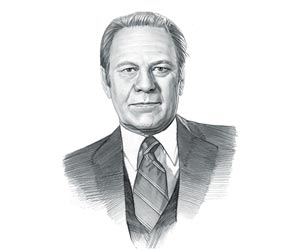|
The first action taken by
Gerald Ford was to grant Richard Nixon an unconditional
pardon. It was a highly unpopular decision and lost Ford
the support of many Americans. He also had to deal with
'Stagflation', a combination of rising prices, inflation
and economic stagnation. The other main events that occurred during the time that
Gerald Ford was president included the 1974
Campaign Reform Law and the Privacy Act of 1974.
His presidency witnessed the rise of the Khmer Rouge
regime (1975-1979) of Pol Pot in Cambodia.
The
1975 Helsinki Accords that dealt with the issues
of cooperation, security and human rights. Gerald Ford died
of cerebrovascular disease on December 26, 2006, aged 93. The next president was
Jimmy Carter.
Birthday:
July 14, 1913
Place of Birth:
Michigan
Political Party:
Republican
Nickname: Mr.
Nice Guy
Number: 38th
President
Vice President:
Nelson A. Rockefeller
Age at Inauguration:
61
Height: 6 feet
Weight: 190
pounds
First Lady:
Betty Ford
Religion:
Episcopalian
Date of Death:
December 26, 2006
Date of Gerald
Ford
Presidency: August 9,
1974 to January 20, 1977
The Nickname of Gerald Ford: Mr. Nice Guy
The nickname of President Gerald Ford provides an insight into how
the man was viewed by the American public during his presidency. The
meaning of the nickname "Mr. Nice Guy" refers to his likable ,
pleasant, clean-cut image and his aversion to causing trouble or
dissent.
Character and Personality Type of Gerald Ford
The character traits of President Gerald Ford can be described
as genial, honest, direct, considerate and diligent. It has been
speculated that the Myers-Briggs personality type for Gerald
Ford is an INTP (introversion, intuition, thinking, perceiving).
A modest, reserved, stoic character with a preference to work
informally with others as equals. Gerald Ford Personality type:
Quiet, analytical, impatient and thoughtful.
Accomplishments of Gerald Ford and the Famous Events during his
Presidency
The accomplishments of Gerald Ford and the most famous events
during his presidency are provided in an interesting, short
summary format detailed below.
The Cold War (1945 - 1991)
Summary of the Cold War:
The Cold War
(1945
- 1991) was a 'war of words' involving the Cold War
Space Race and the Cold War Arms Race involving the nuclear build-up
between the USA and the West and the Communist countries dominated
by the USSR and China in the East.
Gerald Ford was one of the nine US Presidents who were in office
during the dangerous period in history known as the Cold War in
which the US adopted the policy of
Containment
to restrict the spread of communism abroad..
Stagflation (1970's)
Summary of Stagflation:
Stagflation
was the term used to describe the state of the nation's economy
during the 1970's. Stagflation was a combination of economic
stagnation, rising prices and inflation. President Richard Nixon
failed to curb stagflation and President Ford faced the worst
recession since the Great Depression. His economic policies
failed to work and stagflation continued into the presidency of
Jimmy Carter. The economy finally began to recover during the
administration of Ronald Reagan.
The Privacy Act of 1974
Summary of the Privacy Act of 1974: The
Privacy Act of 1974
provided safeguards against the invasion of personal privacy through
the misuse of data
The Khmer Rouge (1975-1979) and the SS Mayaguez Incident (1975)
Summary of the Khmer Rouge: The
Khmer Rouge
(1975-1979) and the merciless regime of Pol Pot in Cambodia hit the
headlines during the SS Mayaguez Incident when an
American cargo ship called the SS Mayaguez was seized by
the Khmer Rouge. The “Mayaguez Incident”, aka the Battle on Koh Tang
(May 12–15, 1975), is officially referred to as the last battle of the Vietnam War.
The Helsinki Accords (1975)
Summary of the Helsinki Accords: The
Helsinki Accords
were a series of agreements that were signed in August 1975 by
leaders of the USA, the USSR and 35 nations who were members of NATO
and the Warsaw Pact. The Helsinki
Accords dealt with three main issues of cooperation, security and
human rights but the agreements were subsequently broken by the
Soviets. |

